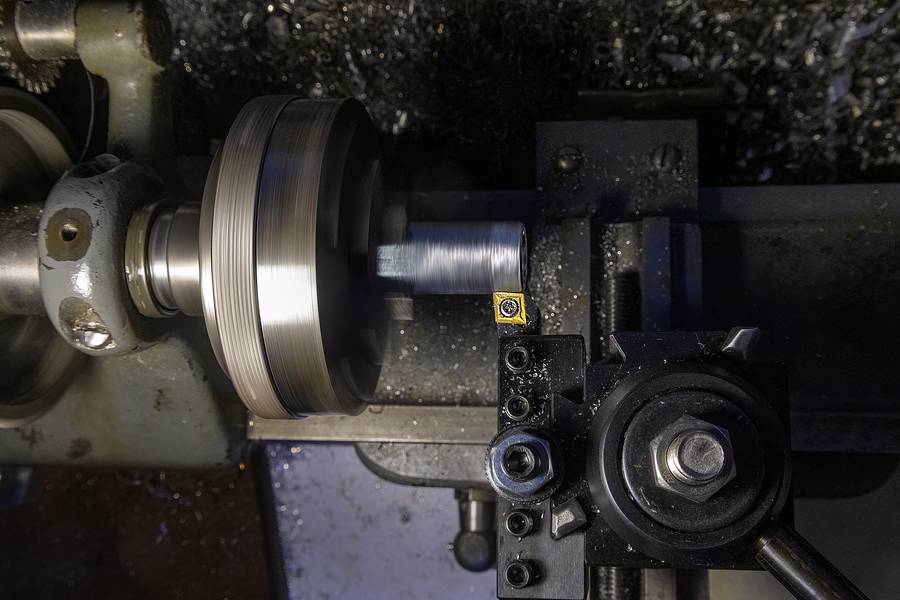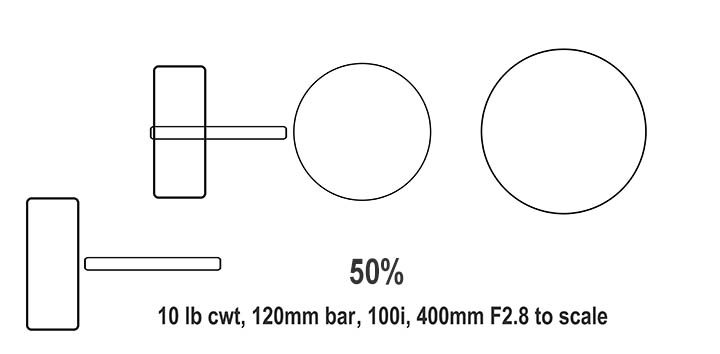Wiring it all up...
11/07/2025. I've omitted a lot of maundering while I figure things out about using the strain wave mount. When I get things nailed down reasonably well, I'll write a succinct account for my own reference and for others.

New tool post on an old lathe.
In other news, the lathe is ready to go again. Rather than mill, saw, or otherwise carve the supplied base, I used a 1/2-inch stainless steel carriage bolt whose head could be whittled down to fit the slot in the cross slide (~25 minutes with a hacksaw; yes, it does look a bit kludged, because it is, but it also feels solid). So there's now an 1890's Barnes lathe downstairs with a thoroughly modern quick-change toolpost. When it's time to buy more carbide inserts, the ones that came with the new tools are size and shape "CCMT09T304". Amazon, Ali, lots of places have 'em.
After aligning the quick-change carriers, a second counterweight for the Wave 100ibecame my first order of business. It's all about options: two weights would let me use a shorter bar (often easier to pack, easier to ship, probably easier to guide, too). Instead of JBWelding the threads into the counterweights ---as I did for one without a set screw-- I turned a couple of rod couplers down into threaded sleeves. Place these where you want the counterweights to mount on the rod; let the counterweights grip them without damaging the rod's threads. An off-ther-shelf coupler or a nut can serve as a toe-saver. These sleeves also mean I can fit the rod alone to the Wave 100i without worrying that the ungainly balance of a rod with counterweight will invite cross threading the socket in the mount. One sleeve tuned down nicely; the other is a mess, but it still works. (I'll almost certainly make another, but it's sheer vanity.) I discovered some slop in the lathe that needed to be adjusted out then got rid of most of it. The new tool post, tools, and inserts are a huge improvement. (The third sleeve was a mess because the carbide insert was worn out from the hammering it took from those hexagonal carbon-steel connectors. I turned the insert around to use a fresh edge and finished a new sleeve in no time.)
A small luggage scale will let me see what combinations of toys fall within acceptable weight ranges for this small mount and help set counterwight arms and masses. Short (150mm) rods are on the way because they'll suffice for most needs and will be much easier to use than the 400mm already one in hand. I know that the TMB92SS and the 400mm Nikkor can be accommodated seperately without any counterweights with capacity to spare, but I would like to think about multiple OTAs, or lower power use, or bigger glass. Speaking of...
Yesterday, I declined an A-P 155CS. I'd been on the list for a 6-inch apo since 1996 or 7. Let's not talk about it right now. (Seriously, it trips a cascade of first-world laments.) Anyway, I had neither a spare $13 - $14k nor any prospect of a place to use it. Just. Don't. Go. There. (https://www.astro-physics.com/155cs)
An 8x50 finder arrived this week via the proverbial slow boat from China (even so, a few days sooner than promised). The elastic bands I had intended to use to fix it to the co-axial mounting bracket (wait'll you see this thing) (ETA: nevermind) were much too short, and while measuring and shopping for longer ones, it occured to me to try a simple loop of elastic cord --voila! Pix to follow because trying to describe the bracket and its harness would be like trying to describe how to tie shoes. [And if it actually worked, it would be worth showing you. It really doesn't. Still thinking about that.] Polar alignment and aiming should be much easier with this addition to the kit. [Note that the elastic bands have a place in the revised guiding kit described down yonder.]
11/09/2025. According to the luggage scale, the 400mm without camera weighs 13.8 pounds. Each of the counterweights I'm prepping for use on the Wave weighs 9.5 pounds. Call it 14 and 10. Add 2 pounds for the R6 or 1600MC, 3 for the 1600MM with filter wheel. Guide scope, camera, and mounting bar: ??. We know from the Lyra photos that 16 pounds without counterweights works great and that the second saddle can hold the guiding hardware. This is why a pair of shorter counterweight bars is on the way: there's just no reason to hang 10 or 20 pounds way out from the axis.
The Wave 100i has a weight limit of 22 pounds without counterweights, 33 with. I confess that I don't understand why there's not simply a 22 pound net weight limit after counterweighting, but let's believe the manufacturer until there's a really good reason to find out. Note that the 5-inch F6 A-P with cradle is 23 pounds.
11/13/2025. Balancing the Wave 100i. The relevant diameter of the mount is 12cm, so its perimeter is 6cm from the RA Axis. The clamp, V-bar, and Arca clamp add 4cm. From the foot to the center of the 400mm lens is 13cm. So, when ready for action, the center of the 400mm is 23cm from the axis (this is 3cm farther than recommended, but the math applies). The lens and R6 weigh 16 pounds. So we're close to the 22 lb limit w/o a counterweight right there. The specified maximum uncounterweighted moment is 22 lbs on a 20cm moment arm (sorry for the mixed units) or 440 kapows (I have to call the hybrid unit something). The 400mm Nikkor (16 lbs and 23cm) exerts 368 kapows of torque or about 85% of uncountered capacity. This OTA could be balanced (zero net kapows) by placing 1, 10-pound counterweight 37cm from the axis (that is, on a bar at 31cm) or 2, 10-pound weights 18cm from the axis (that is, at the 12cm mark on a counterweight bar). Keep in mind that there's no need (and perhaps no desire) to completely offset the ota's torque. Offsetting even 50% of an instrument payload will help things along, reducing power draw if nothing else.

Scale diagram of Wave 100i with 120mm bar, 10 pound weight,
and 400mm lens on a Canon R6, with the torque of the instrument
package reduced by 50%.
2025/11/15. Now, about the guiding hardware. These calculations do not take into account the mounting of the guide 'scope on the secondary saddle which means the counterweights do not need to be extended quite as far. I've yet to think very much about the published 33 lb limit with counterweights. Why does it exist? Why is it what it is? Perhaps the 33# specification reflects the limit using the particular mass and length of the OEM counterweight kit.
Further maunderings: the ungainly v1.0 of the guidescope / camera / d-plate assembly has given way to something simpler. First I overthought it, then I un-thought it while trying to force the first version to work. The new guiding package weighs 2.2 pounds, and the cg is much closer to the RA axis -- maybe 20-24 kapows. This arrangement of the guide package will move the dec balance skyward more than it will affect RA. Just ignore it until you find that you oughtn't.
Note from a dry-run on the porch to check for interference with this configuration: when you select Utility/Advanced/Auto-home to park the mount and end a session, the mount will rotate back to home position via the shortest route. It will not "unwind" the route it took to get where it is. Nothing will collide, but cables may run out of slack during this maneuver.
I think I can put all to work under the actual sky on Monday night (today is Saturday).
:: top :: |